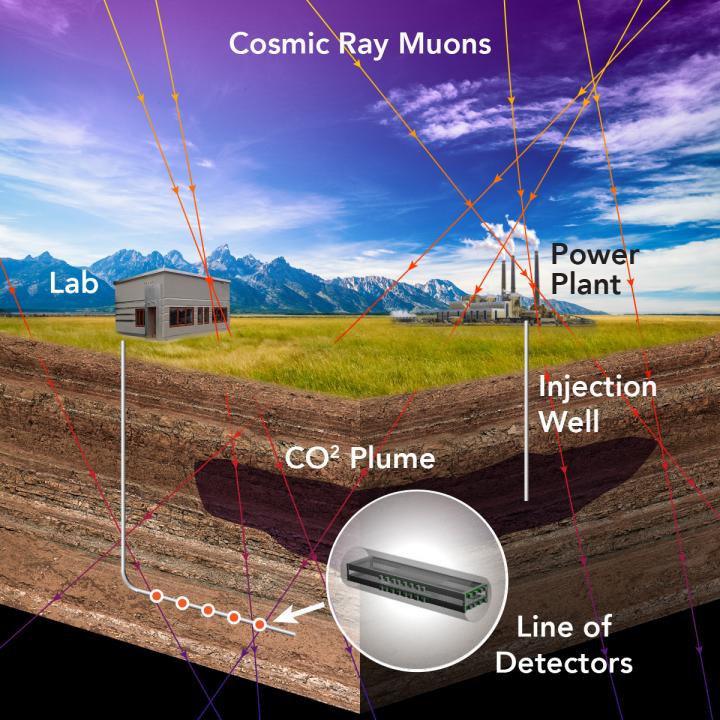Many muons: Imaging the underground with help from the cosmos

This illustration shows how a series of five borehole muon detectors could be deployed in a horizontal well below a carbon dioxide reservoir. Credit: PNNL
Borehole muon detector advances imaging and monitoring of CO2 storage sites
Muons, once used to explore the inside of pyramids and volcanoes alike, are enabling researchers to see deep underground with a technological breakthrough from PNNL.
Invisible to the naked eye, muons are elementary particles created by the collisions of cosmic rays with molecules in the atmosphere. Muons are constantly raining down on the earth at various angles.
They can pass through materials, such as earth and rock, and detecting these particles have helped researchers “see” the inside of structures such as the pyramids of Giza. But the detectors — which measure the number and trajectories of muons hitting the detector — are rather large, about the size of a small car.
In order to be able to “see” changes in density underground, the detectors need to be much smaller. PNNL researchers and their partners have created a smaller — just six inches in diameter and about three feet long — and more rugged version. This mini detector will be able to go thousands of feet underground via horizontal boreholes.
The borehole-sized detectors are made out of plastic components and optical fibers that carry signals to electronics to count each muon that passes through the device. This summer, researchers tested its output against two existing large detectors in a tunnel at Los Alamos National Laboratory.
The results were the same as the larger machines developed by LANL and Sandia National Laboratories. Like its big brothers, the small detector can measure anomalies in the flux of muons that pass through.
A change in the number of muons hitting the detector during a certain period and space indicate a change in density within the structure or object — for instance a plume or reservoir of carbon dioxide underground.
The data convert to an image and both could help monitor CO2 movement or leakage underground at a sequestration site, and have applications for a wide variety of subsurface imaging.
###
Interdisciplinary teams at Pacific Northwest National Laboratory address many of America's most pressing issues in energy, the environment and national security through advances in basic and applied science. Founded in 1965, PNNL employs 4,400 staff and has an annual budget of nearly $1 billion. It is managed by Battelle for the U.S. Department of Energy's Office of Science. As the single largest supporter of basic research in the physical sciences in the United States, the Office of Science is working to address some of the most pressing challenges of our time. For more information on PNNL, visit the PNNL News Center, or follow PNNL on Facebook, Google+, LinkedIn and Twitter.
Media Contact
All latest news from the category: Interdisciplinary Research
News and developments from the field of interdisciplinary research.
Among other topics, you can find stimulating reports and articles related to microsystems, emotions research, futures research and stratospheric research.
Newest articles

A ‘language’ for ML models to predict nanopore properties
A large number of 2D materials like graphene can have nanopores – small holes formed by missing atoms through which foreign substances can pass. The properties of these nanopores dictate many…

Clinically validated, wearable ultrasound patch
… for continuous blood pressure monitoring. A team of researchers at the University of California San Diego has developed a new and improved wearable ultrasound patch for continuous and noninvasive…

A new puzzle piece for string theory research
Dr. Ksenia Fedosova from the Cluster of Excellence Mathematics Münster, along with an international research team, has proven a conjecture in string theory that physicists had proposed regarding certain equations….



